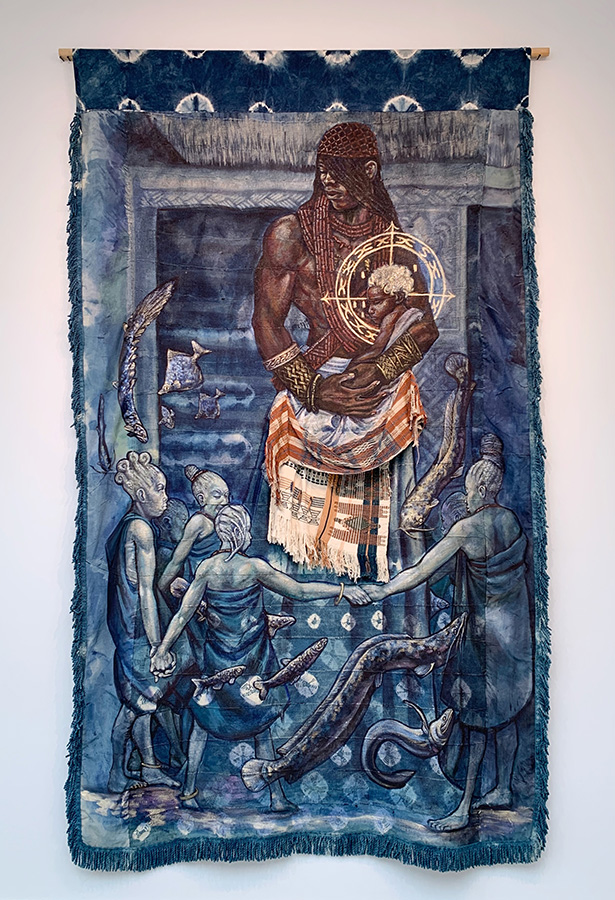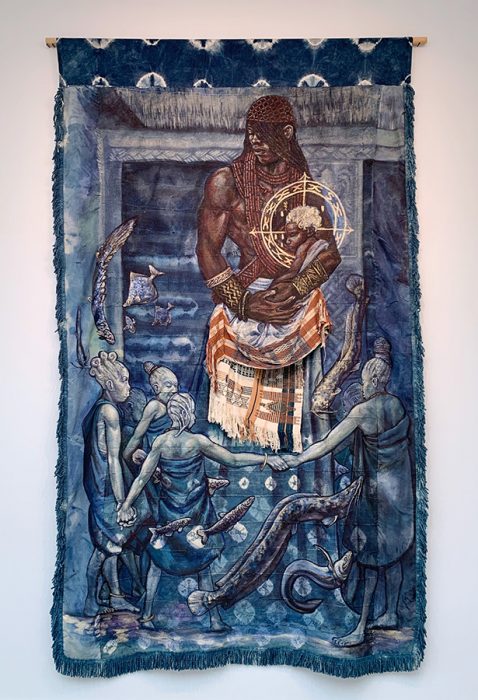November 7, 2024

Transcript by Gallery and Curatorial Fellow Cat Teo

Stephen Hamilton’s painting Omolokun, is his largest to date. The piece, which stretches 85” wide and 130” tall, is made of indigo dyed handwoven cotton cloth and gauze. Hamilton used different panels of materials that he dyed and stitched together to create this monumental canvas. . Using acrylic paint, Hamilton depicts a large man holding a baby, encircled by numerous small, children holding hands. The man looks downwards as he cradles the baby, whose head is surrounded by an ornate golden ring. Toward the edges of the composition, various types of fish and eels weave through the scene, swimming around the central figures.
In this piece, Hamilton is making direct references to the art and religion from the Benin Kingdom and Yorubaland, historical West African civilizations. Water, which holds enormous cultural significance to many West African populations is one of the central themes of this piece. Water has a strong association with wealth and fertility; people are known to offer sacrifices to encourage abundance and prosperity in their lives and for their loved ones. Another important association that water has in these cultures is the correlation between water and the gateway between the world of the living and the world of spirits.
This painting surrounds the water deity Omolokun, a male water deity that is thought to be linked with the Ethiopian Rivers in Nigeria. As a water deity, he is believed to help bring children into the world. Women will often give sacrifices to him when they wish to conceive or are dealing with a difficult pregnancy. In West African myth, children often live with Omolokun inside his palace before they come to the world of the living. In Hamilton’s piece, he depicts an image of a child entering into the world from the deitie’s watery realm. Omolokun cradles the child in his arms, however the baby struggles to enter the living world. The gold marking around the baby’s head represents a chalk drawing that is often used by priests when a woman is having a challenging pregnancy. The drawing is thought to assist the child’s safe transition into the world of the living.
The children that are painted beneath Omolokun represent spiritual figures that live within Omolokun’s palace. They are the playmates of the child who is being brought into the world. The faces of the children vary, since the relationship between the playmate children and the cradled child will be perplexing due to them living in different spiritual realms. Hamilton stated that there is a layer of ambivalence that was purposeful in this painting since the spirit children may try to call the baby back into their world.
Within Omolokun, Hamilton uses fabrics with contrasting textures he’s dyed with indigo as the canvas for his painting. Omolokun relies heavily on indigo dye to create depth through the dark, rich blues at the edges of the piece contrasting with the paler blue of the children’s skin tones. Indigo dye holds enormous significance within Hamilton’s work. Traditional African weavings and fabrics dyed with Indigo are incorporated into many of his pieces. The fabrics each take the dye a bit differently, allowing the viewer to see the texture beneath the painting. The dye itself is thought to be something of great beauty and value in Africa; indigo and indigo dyed fabrics are potent and powerful within African beliefs, making it a coveted substance and a sacred part of the culture.
The piece Omolokun by Stephen Hamilton gives us a deeper understanding of African beliefs and traditions. Through his portrayal of the deity Omolokun, Hamilton is able to illustrate the deep connection that African culture has to water, life, and spiritualism.